Did you know that mollies, those gorgeous and easy-to-care-for fish, are part of the same genus as guppies, platies, and limias? It’s true!
These aquatic wonders are a favorite among aquarium enthusiasts due to their stunning array of colors and patterns, as well as their simple care and breeding needs.
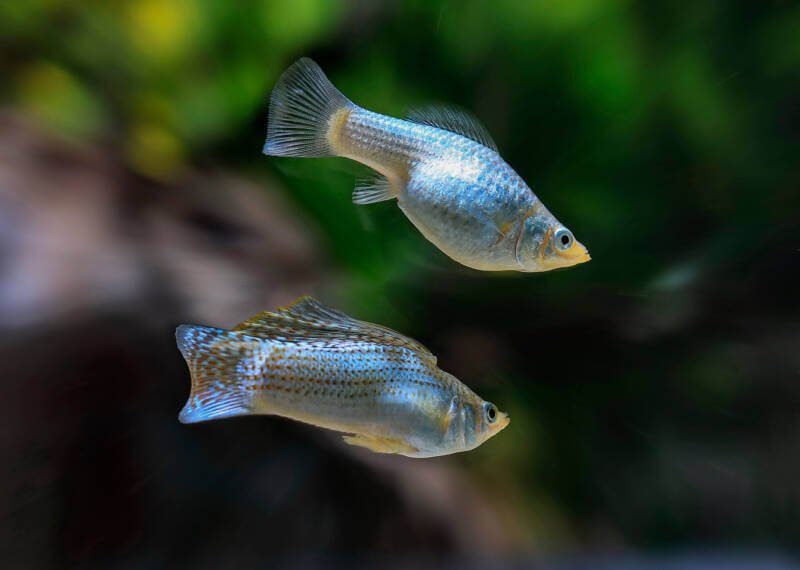
Found throughout Central and North America, mollies are adaptable to a variety of water conditions, making them a hardy and low-maintenance addition to your aquarium.
Plus, their calm and peaceful demeanor make them perfect for community tanks with other colorful fish species.
So why not add some mollies to your aquarium today and experience the joy and beauty they bring?
At a Glance
| Tank Size: | 20 gallons (90 l) |
| School Size: | minimum of 4 |
| Temperature: | 75-80°F (24-27°C) |
| Lifespan: | up to 5 years |
| Size: | up to 4.5 inches (11 cm) |
| pH: | 7.5-8.5 |
| Hardness: | 15-30 dH |
| Ammonia: | 0 ppm |
| Nitrite: | 0 ppm |
| Nitrate: | <30 ppm |
In this article
In the Wild
In older aquarium references, mollies carried the genus Molliensia. That name got retired when scientists discovered how close the genetic link between mollies, guppies, and other livebearers was.
The old genus was retired, and now they all share the Poecilia genus.
Mollies come from the Southern United States throughout the entire Yucatan peninsula.
While freshwater fish, they CAN tolerate brackish and even seawater for short periods! It isn’t their chosen habitat, though.
Instead, they gravitate to rivers, streams, and pools with dense plant cover.
The vegetation provides sufficient hiding places from the birds and other predators that feed on them. It also serves as a hunting ground for the invertebrates and algae they prefer to feed on.
Popular Types of Mollies
The types are divided by size and shape into shortfin mollies and sailfin mollies.
Shortfin mollies resemble platies with deeper chests. Sailfin mollies have larger dorsal and caudal fins, and they include the lyretail group.
1. Common molly (Poecilia sphenops)
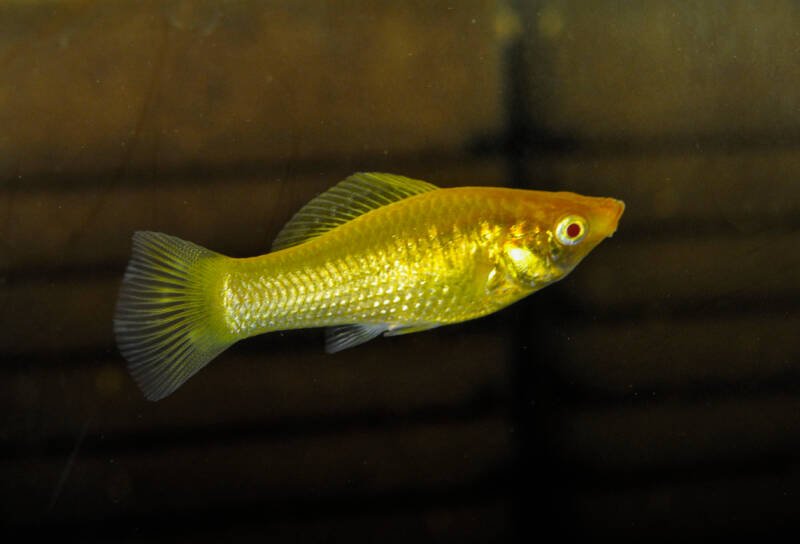
The common molly represents the most abundant molly type. They come in a variety of colors, including the famous black molly.
Black mollies represent one of the genuinely jet-black fish available for the freshwater aquarium.

2. Sailfin mollies (Poecilia latipinna)

Sailfin mollies carry a prominent dorsal fin. The sail extends high over the fish’s back, drifting over to the tail in a lazy sail shape.
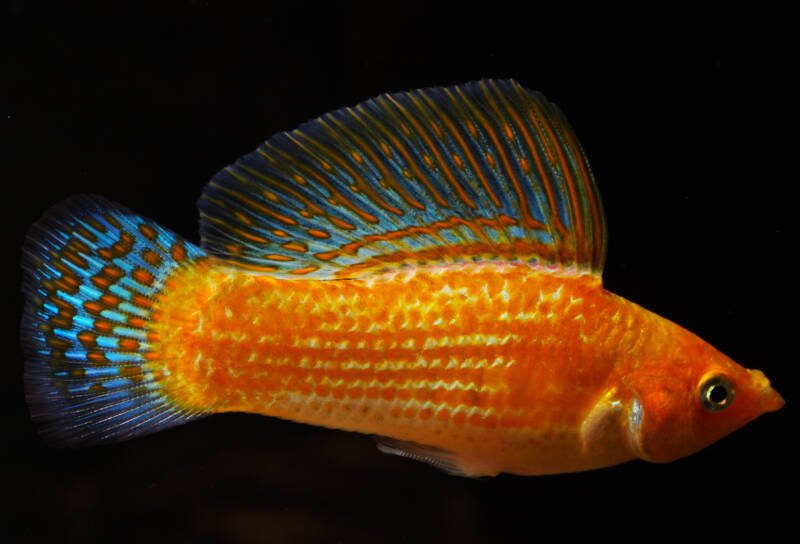
You can choose from different patterns and colors, including a black type.
3. Lyretail variation
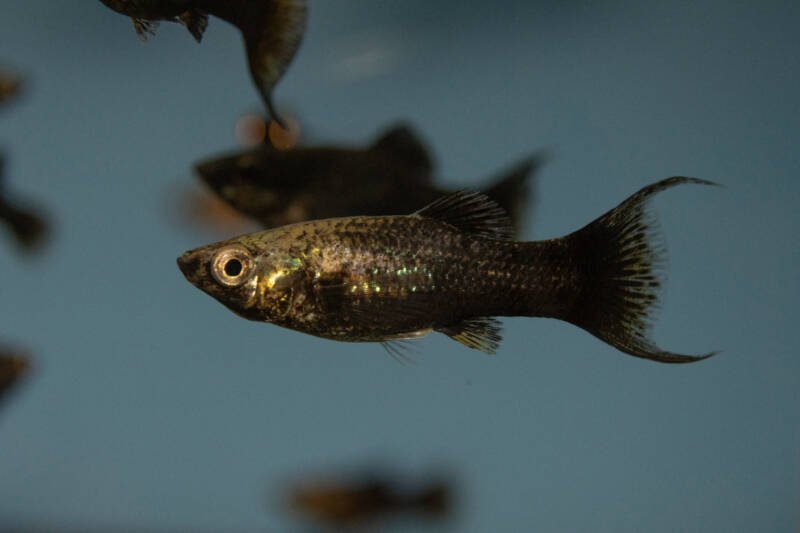
Rather than elongating the dorsal fin, lyretail mollies exaggerate their caudal fin. The very ends narrow to prominent points that sweep behind the fish as they swim.
You get the same delicate points off the dorsal and anal fins, making these elegant mollies.

4. Balloon mollies
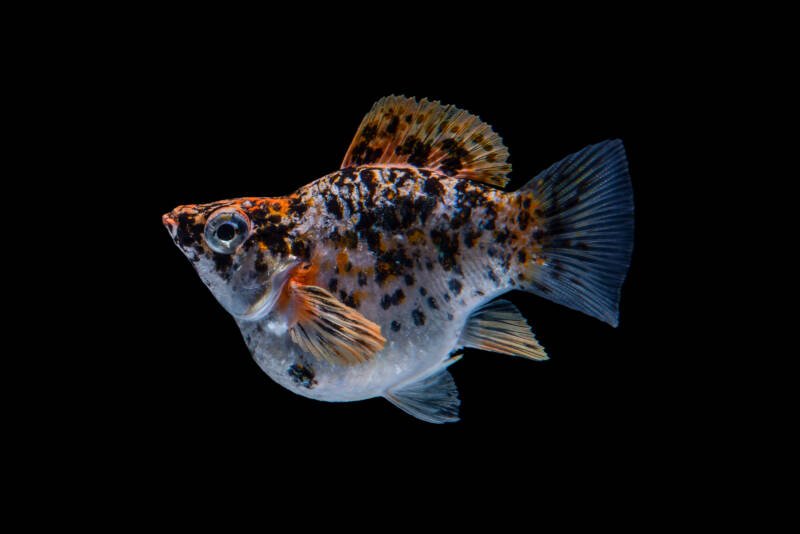
Balloon mollies are a subject for debate. Man-made varieties, they have distended abdomens and come in three color options (black, yellow, and white).
The prominent belly makes them slower swimmers, which many argue is cruel. DON’T put them with aggressive feeders.

Size
In their native habitat, mollies reach a standard length of 5 inches (13 cm).
However, in captivity, you’ll have to settle for a slightly smaller expectation. When kept in tanks, mollies range between 3-4 inches (7-10 cm).
Some of this disparity comes from the captive breeding process. Most mollies in the pet trade are cultivated in Asia. There, it’s cheaper to raise them in tanks of brackish water.
The fish survive, but the sudden shock of a freshwater tank hampers their kidneys and slows down their growth.
Molly Lifespan
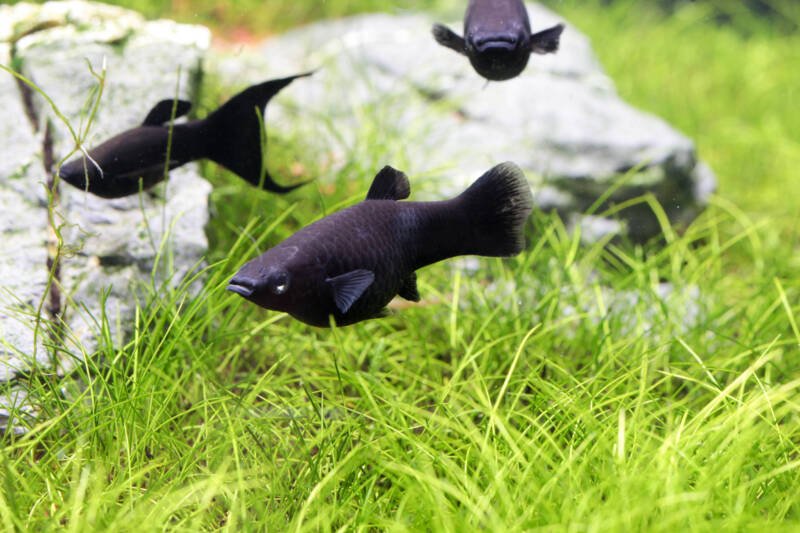
Mollies live an average of 3-4 years. With pristine aquarium management, you might see that lifespan extends up to 5 years.
Luckily, these livebearers are so easy to breed, you’ll have plenty of generations to replenish your tank.
Behavior
With a peaceful temperament, mollies make great additions to community tanks. They get along well with other fish with similar sizes and calm natures.
Avoid more aggressive tank mates, or they’ll spend more time hiding in the plant life.
Unlike the guppies, which share the Poecilia genus, mollies prefer to stay in schools. You’ll need a minimum of four fish to stave off nervous behaviors.
With a proper group, they’ll shoal together and remain active within your tank.
However, there’s a catch. You need to strike the right balance between the sexes.
Keep three females for each male. Due to the ease of breeding, males harass females, and limiting the number of males keeps the reproductive stress to a minimum.
Tank Setup
Mollies in the wild frequent the shallower parts of rivers and streams. This allows you to keep these livebearers in smaller tanks.
If you only have one or two, a 10-gallon (38 l) tank will do fine. However, the need for a school means a minimum of 20 gallons (76 l).
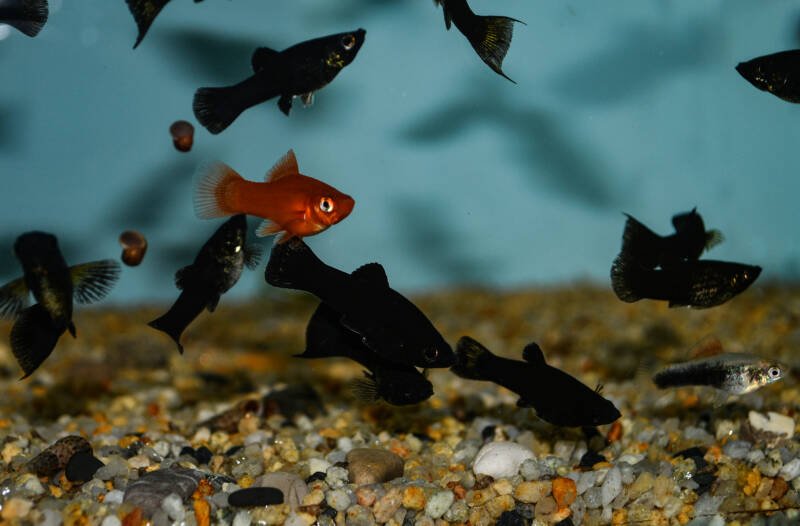
When selecting your tank size, choose an appropriate filter. Mollies produce A LOT of waste. You’ll want a biological media filter, at a minimum.
If you have a community aquarium, consider multiple filters to keep up.
Water Conditions
The molly is a tropical freshwater fish. As such, you’ll need to invest in a quality heater for your aquarium.
Aim to keep your water temperature between the range of 75-80°F (24-27°C). If the mercury drops too low, your mollies will become lethargic.
Mollies prefer neutral to slightly alkaline waters. A pH between 7.5-8.5 works best.
You’ll have to make your call on whether to mix salt into the tank. Consider speaking with the breeder you purchase your mollies from.
The natural habitat mollies inhabit come with a high mineral load. As such, they don’t do well in softer waters. You’ll want a water hardness around 15-30 dH.
If your water source lacks minerals, add a mesh bag of crushed coral to your tank to boost your mineral content.
Decorating the Molly Tank
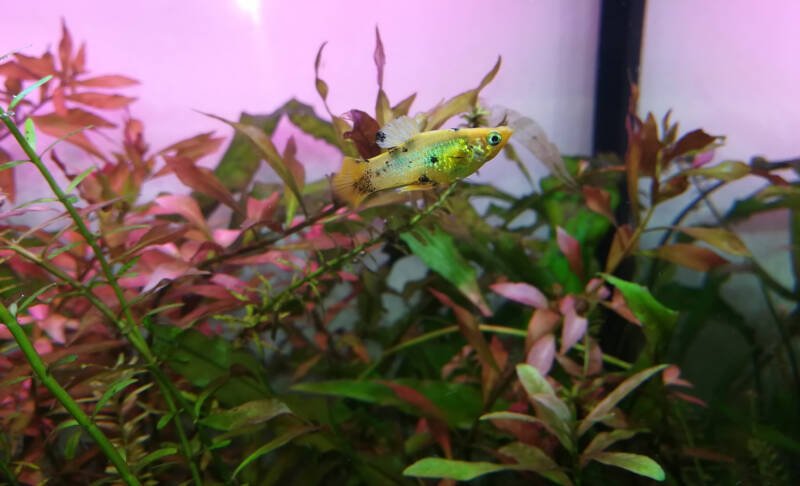
In their natural environment, mollies seek out regions with sandy bottoms studded with rocks.
The soft substrate provides the perfect medium for plant growth, while the stones allow the mollies hiding places from larger, more aggressive fish.
The shallow waters allow PLENTY of plant growth. You’ll want to provide your mollies with a perimeter of plants to make them feel at home.
Choosing an aragonite sand will provide the perfect anchor for the following options:
1. Leptochilus
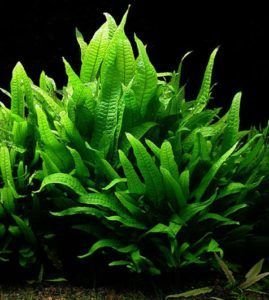
2. Anubias

3. Vallisneria

4. Sagittaria

Rocks and grottos give your school of mollies somewhere safe to retreat if you have more aggressive tank mates.
Just remember, mollies prefer to swim in the middle and upper part of the water column.
Mollies in a Community Tank
Most schooling fish have calm natures. That makes it tempting to pair mollies with other shoals.
However, mollies have voracious appetites, and they’re larger than some freshwater fish. As such, they may outcompete your favorite species.
Tank Mates

If you want the most harmonious community tank, select fish that are peaceful, complementary in size, and quick on their fins.
Or at least choose fish that prefer to swim at a different level in the aquarium. Your best options include:
- Bristlenose plecos
- Cherry barbs
- Clown plecos
- Corydoras
- Danios
- Dwarf gouramis
- Harlequin rasboras
- Platies
- Rosy barbs
- Swordtails
- Tetras
- Yo-yo loaches
- Zebra loaches.
For those that include invertebrates in their tank, mollies aren’t interested in harassing snails or freshwater shrimp.
You can safely keep those little algae-eaters in the aquarium without worrying they’ll turn into a molly snack.
Incompatible Species
At the opposite end of the spectrum, avoid pairing your mollies with larger or more aggressive species.
Even if you provide grottos for hiding places, cichlids have no problem pursuing your mollies to take a bite out of the school.
Feeding Your Mollies
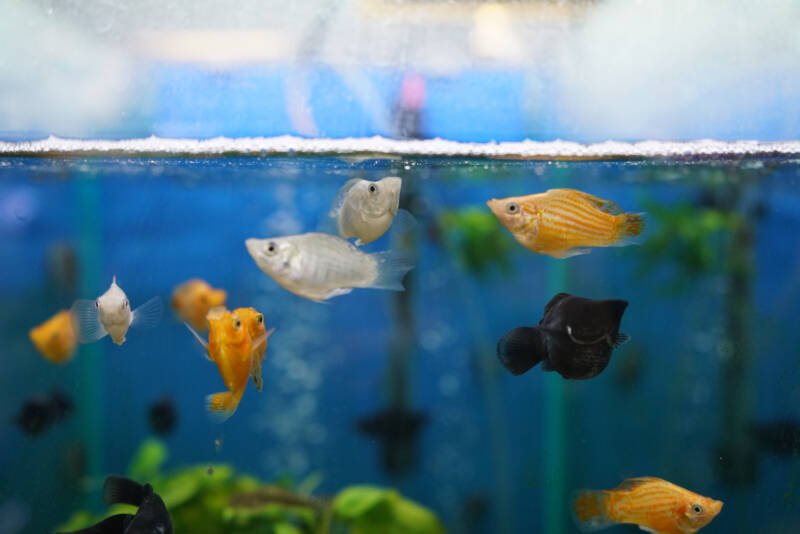
Officially, mollies rank as omnivores. However, they lean towards the herbivore side of the scale. They have a weakness for algae.
This appeals to a lot of aquarists, as the school happily tackles algae build-up in the tank.
Mollies use their lips to scrape algae from the plants and decorative surfaces within your aquarium.
If you don’t have sufficient algae (or they’re competing with other algae-eaters), you’ll need to supplement their diet with other algae sources:
If you want to contribute some extra greens, mix some blanched vegetables to supplement their algae diet.
Chop up pieces small enough for them to chew. Suitable options include:
- Lettuce;
- Spinach;
- Zucchini.
Of course, if you want to keep their colors looking fresh and vibrant, you need to provide variety and balance.
That means introducing some protein onto the menu now and then. Bloodworms and brine shrimp are always top favorites.
You CAN offer frozen options, but if you’re willing to invest in live foods, you’ll keep your mollies’ scavenging instincts working at peak perfection. Plus, it’s exciting to watch them dash around after their prey.
Rounding out the diet with commercial fish food won’t harm them. Omega One Freshwater Flakes (or your preferred flake or pellet) works fine.
Only feed as much as the school can eat in two minutes to avoid excess waste. Twice daily feedings are plenty.
Mollies: One of the Livebearers
As with all members of the Poecilia genus, mollies are livebearers. This means, instead of laying eggs, they give birth to live fry.
It may sound complicated, but mollies rank as one of the easiest freshwater fish to breed. So easy new aquarists might want to avoid mixed sexes.
Male or Female?

Determining whether you have a male or female molly is reasonably straightforward.
As with most species of fish, males grow larger. They aren’t as rounded as females. As females gestate, that rounding grows more prominent.
Male mollies have a prominent “sailfin.” This is the dramatic shape of their dorsal fin.
Females still carry a dorsal fin, but it isn’t as large or impressive. As males use the sailfin to attract the females, this makes sense.
Along with that sailfin, males have more prominent, vibrant coloring. Females carry more subdued versions of their colors and patterns.
It’s the color and impressive display that encourages a female to choose a specific male.
Finally, the anal fin stretches out longer and larger than that seen in the female. The anal fin modifies into a gonopodium, which allows for molly copulation.
Females have a triangular anal fin, in comparison.
Breeding
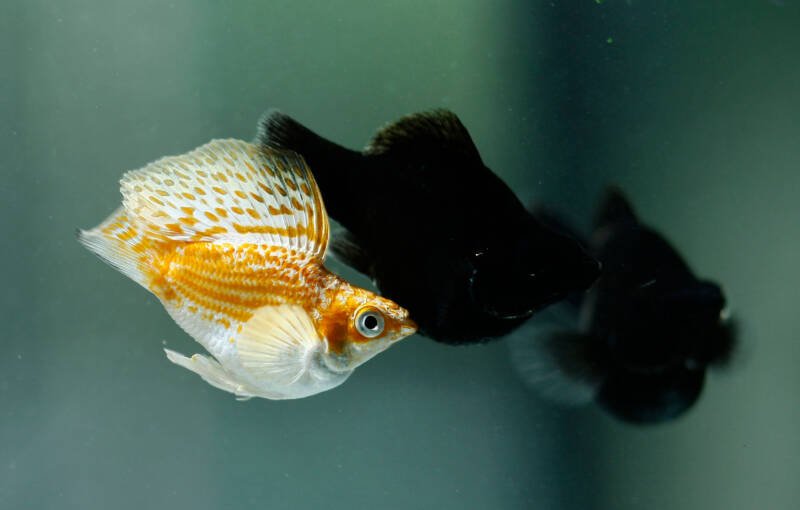
As an aquarist, your job in breeding mollies is simple. You need only add a male and female into a tank.
You’ll end up with fry eventually. It’s THAT SIMPLE. However, if you’re interested in the mechanics, read a little further or have a look at our guide.
Mollies require pristine water conditions to optimize breeding.
You can also help the situation by bumping the temperature slightly, but don’t go higher than 78°F (25.5°C).
And make sure there’s plenty of plant cover, so the fry have hiding places.
Female mollies select the males. Some males attempt to sneak up on females, but it rarely works.
Instead, they put on dramatic displays to show their worth. The pair undergo copulation, and you’ll notice a gravid spot near the base of the female’s anal fin.
The gravid spot forms as the body wall stretches with the eggs’ development. There’s no umbilical connection as you find in mammals, but the mother’s system provides the nutrients to the embryos contained within the eggs.
After 35-45 days, the fry hatch. A female can produce up to 100 fry, though you may not get them all to survive.
Mollies cannibalize their young (which is why you need that crucial plant cover).

Molly Health
Despite the relative ease of setting up the molly tank, these livebearers are the most delicate in the Poecilia genus.
If temperatures slip too low or they become stressed for any reason, they develop a condition known as “molly disease.”
Better known as “the shimmies,” this condition is a reaction to poor water conditions.
Shortly after your water quality slips, you’ll start to see the following:
- Decrease in activity
- Staying in one place in the tank
- Wiggling or “shimmying.”
The behavior is your warning that something’s wrong. A quick restoration to normal water conditions and your mollies will resume normal behavior.
“The shimmies” aren’t infectious, but you still don’t want to stress your fish.
In addition, mollies are susceptible to ich and velvet disease. You’ll see a decrease in appetite, drop-offs in activity, and the stereotypical spots.
Make sure you isolate affected fish right away so you can get them treatment.
Mollies: Are They for You?
Mollies make excellent choices for aquarists of every level. They make for dazzling colors and patterns against planted backdrops.
While rarer types may run higher, they cost between $2-$4 a fish, allowing you to easily fill an aquarium with a school without breaking the bank.
Mollies integrate into community tanks well. Provided their tank mates can compete against their raging appetite and swimming speed, anyway.
Whether you keep mollies on-hand for algae clean-up or for the delight of watching the school dance through the water, these active livebearers make excellent choices for every aquarist.
Just mind your water quality, so they don’t start shimmying.
Do you keep mollies in your tank? Have you had any problems arise?
Are they as simple to breed as claimed?
Share your stories and questions here!